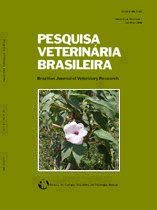 |
|
|
|
Year 2012 - Volume 32, Number 1
|

|
Experimental poisoning of goats by Ipomoea carnea subsp. fistulosa in Argentina: A clinic and pathological correlation with special consideration on the central nervous system, 32(1):37-42
|
ABSTRACT.- Ríos E.E., Cholich L.A., Gimeno E.J., Guidi M.G. & Acosta de Pérez O.C. 2012. Experimental poisoning of goats by Ipomoea carnea subsp. fistulosa in Argentina: A clinic and pathological correlation with special consideration on the central nervous system. Pesquisa Veterinária Brasileira 32(1):37-42. Cátedra de Farmacología, Facultad de Ciencias Veterinarias, Universidad Nacional del Nordeste, Sargento Cabral 2139, 3400, Corrientes, Argentina. E-mail: patmed@vet.unne.edu.ar
Ipomoea carnea subsp. fistulosa, aguapei or mandiyura, is responsible for lysosomal storage in goats. The shrub contains several alkaloids, mainly swansonine which inhibits lysosomal α-mannosidase and Golgi mannosidase II. Poisoning occurs by inhibition of these hydrolases. There is neuronal vacuolation, endocrine dysfunction, cardiovascular and gastrointestinal injury, and immune disorders. Clinical signs and pathology of the experimental poisoning of goats by Ipomoea carnea in Argentina are here described. Five goats received fresh leaves and stems of Ipomoea. At the beginning, the goats did not consume the plant, but later, it was preferred over any other forage. High dose induced rapid intoxication, whereas with low doses, the course of the toxicosis was more protracted. The goats were euthanized when they were recumbent. Cerebrum, cerebellum, medulla oblongata, pons and colliculi, were routinely processed for histology. In nine days, the following clinical signs developed: abnormal fascies, dilated nostrils and abnormal postures of the head, cephalic tremors and nystagmus, difficulty in standing. Subsequently, the goats had a tendency to fall, always to the left, with spastic convulsions. There was lack in coordination of voluntary movements due to Purkinje and deep nuclei neurons damage. The cochlear reflex originated hyperreflexia, abnormal posture, head movements and tremors. The withdrawal reflex produced flexor muscles hypersensitivity at the four legs, later depression and stupor. Abnormal responses to sounds were related to collicular lesions. Thalamic damage altered the withdrawal reflex, showing incomplete reaction. The observed cervical hair bristling was attributed to a thalamic regulated nociceptive response. Depression may be associated with agonists of lysergic acid contained in Ipomoea. These clinical signs were correlated with lesions in different parts of the CNS. |
| |
|
|
| |
|
 |